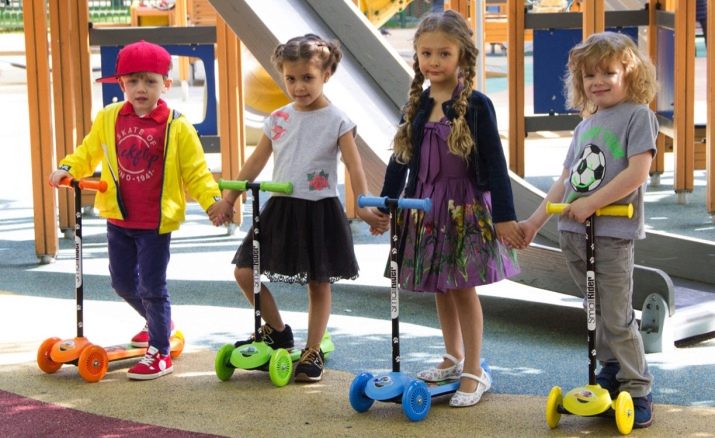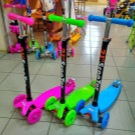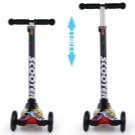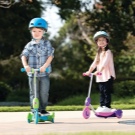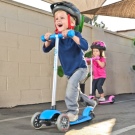Scooters are a fairly common form of transport and are very popular in urban environments. However, controlling a scooter requires the ability to maintain balance, which is simply beyond the power of young children. The creation of three-wheeled models completely solved this problem, making the scooter a favorite fun for kids and their parents.
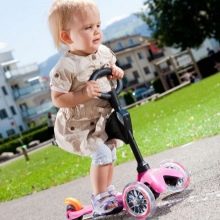
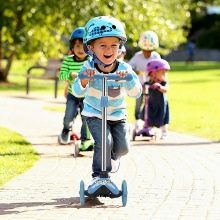
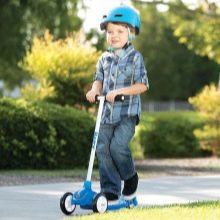
Features
The three-wheeled scooter is a very simple design, consisting of a steering wheel, a deck and wheels, and is distinguished by reliability and high maneuverability. Despite its unpretentiousness, it is an ideal option for training motor skills and coordination in children and a great way to spend leisure time in older children. The most popular 3-wheel models have won in children under 5 years old. This is due to the fact that the scooter often acts as an excellent alternative to a children's tricycle, comparing favorably with it compactness, light weight and ease of operation.
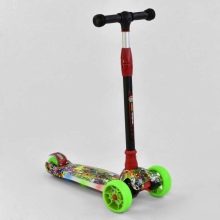
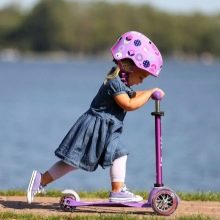
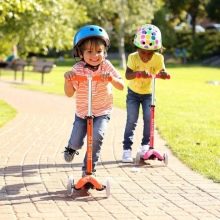
It often happens that babies, especially up to the age of 3, are reluctant to sit on a bicycle, unless it is equipped with a pusher handle. It is physically difficult for a small child to pedal, which is especially noticeable when the child is seated on a brand new, just bought and not yet “circled” bicycle. With a scooter, such problems, as a rule, do not arise, and even 2-year-old children quickly figure out what's what, and begin to ride on their own.
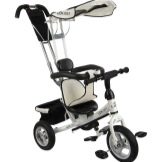
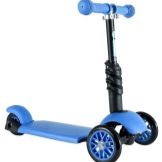
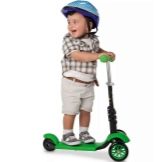
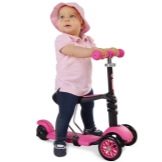
As a material for the manufacture of three-wheeled scooters use steel, aluminum alloy and high strength plastic. Plastic models are much lighter than their metal counterparts, but they fail faster and are designed for babies up to 3 years old.
For the manufacture of preschool, adolescent and adult models, light aluminum alloys and stainless steel are used.
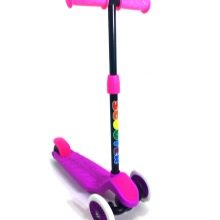

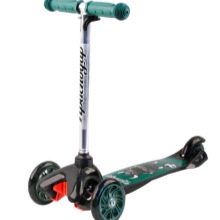
Scooter wheels are made of polyurethane, plastic and rubber. Plastic wheels make the scooter much easier and cheaper, but they rattle a lot when driving on asphalt or tile. Inflatable wheels with rubber tires have an excellent cushioning effect and are absolutely silent. Their disadvantage is the need for constant monitoring of tire pressure and rubber integrity. Polyurethane wheels are considered the most practical and convenient: they do not rustle, do not require maintenance, perfectly absorb road irregularities and do not wear out.
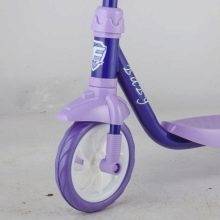
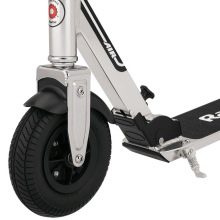
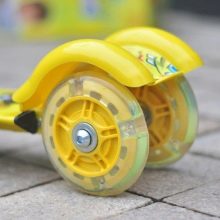
The wheel of a three-wheeled scooter is made of metal and equipped with soft grips or plastic handles. For most models, it has a telescopic design and is adjustable for the growth of the rider. The rear wing acts as a brake system for children's models, when pressed, the wheel stops. Adult and adolescent models are equipped with full manual rim or disc brakes.

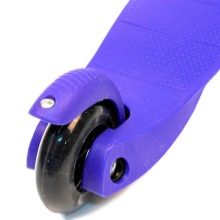
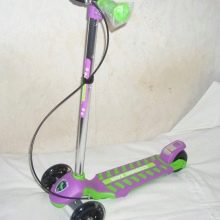
The platform for legs (deck) on most models has a corrugated, rubberized or rough design, providing reliable traction of the sole with the surface of the scooter. Its width depends on the size of the vehicle and ideally should fit both feet. An equally important part of the scooter is a folding mechanism. The presence of a movable unit makes it easy to fold the product, thereby providing convenient transportation and storage, and if necessary - quickly disassemble.
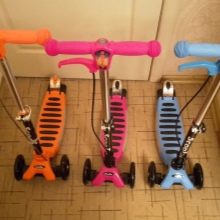
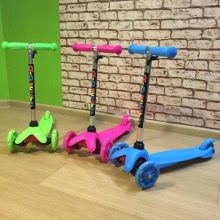

Advantages and disadvantages
High consumer demand for three-wheeled scooters due to a number of undeniable advantages of these compact and light vehicles.
- Due to the small size, scooters can be transported in public transport and taken to the store with you. In addition, unlike most bicycles, they fit perfectly in passenger elevators.
- Riding a scooter is much easier than riding a tricycle. A child can quickly go down to the ground at any time without the help of an adult.
- The cost of three-wheeled scooters is much lower than the cost of bicycles, which makes them even more popular and affordable.
- Due to the presence of the third wheel, the models have good stability and do not require the skill of maintaining balance.
- Due to the simple design and the lack of complex components, scooters rarely break and last long enough.

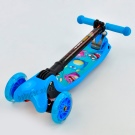
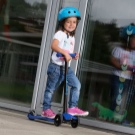
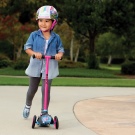
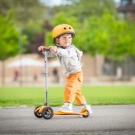
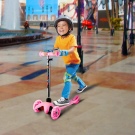
Among the minuses can be noted the low location of the wheels, bearings and the swivel mechanism, because of which they are quickly contaminated with sand and dust.
This causes an unpleasant creak that intensifies with a set of speed. The disadvantages include the presence of play, which is especially typical for models in which the twin wheels are in front and are connected to the steering column by means of a reciprocating axial spring.
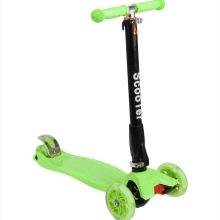
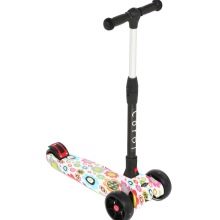
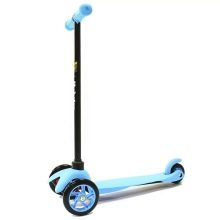
Besides, in folding models, the moving unit becomes loose over time, which leads to the mobility of the parts relative to each other, which of course should not be. However, the more significant drawback is the likelihood of the scooter falling to one side when passing sharp turns, as well as the risk of flying over the steering wheel when hitting an obstacle. Loss of stability is more typical for models in which the paired wheels are located at the rear, and “flying” through the steering wheel is more common in models with the front arrangement of paired wheels, which is due to the forward center of gravity shifted forward.
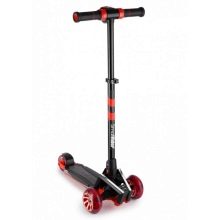

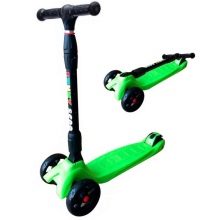
Species overview
Three-wheeled scooters are classified according to the following criteria:
- arrangement of wheels;
- age distinctions;
- type of drive.
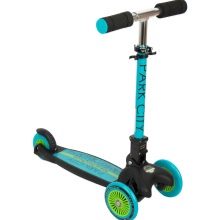
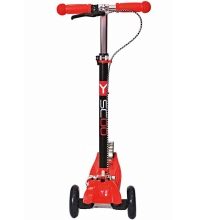
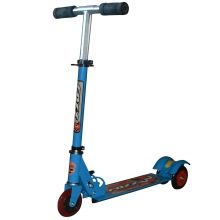
As for the location of paired wheels, they can have front and rear locations. The front is considered more stable and is found on children's models for preschool age.The control is provided by the return axial spring of the tilt-and-tilt mechanism, which instantly “informs” the wheels of the change in steering position, after which they obediently turn in the right direction. Twin-wheel scooters are great for rough roads. They are not very stable in bends, but thanks to the classic steering wheel connected directly to the wheel fork, they are characterized by higher maneuverability and cross-country ability.
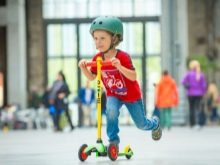
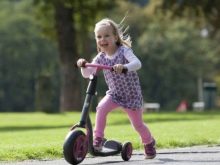
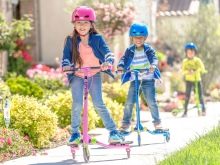
The age classification divides scooters into 3 categories:
- children’s;
- teenage;
- adults.
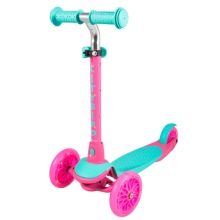

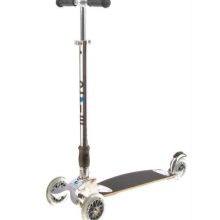
Models for children represent the largest group of three-wheeled vehicles and are available in a large assortment. Teenage models are represented mainly by butterfly scooters, or, as they are also called, traders. The deck of such models consists of three parts, one of which is static and adjacent to the steering column, and the other two are movable relative to the common axis and are equipped with small wheels. The movement on the traders is due to the shift-apart of the floating decks, while the rider does not touch the ground with his feet and is constantly on the scooter.
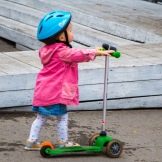
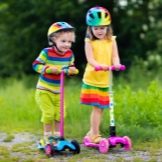
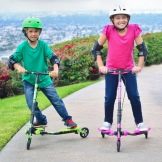
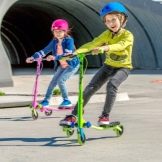
Adult three-wheeled models are the smallest category and are represented by electrical and inertial samples.
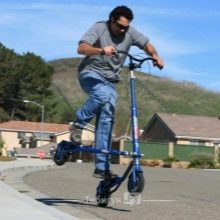
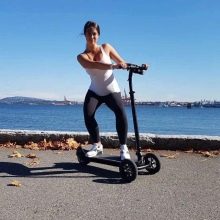

The next sign of classification is type of drive. According to this criterion, foot models are set in motion by repulsion from the ground, and electric scooters. Models powered by an electric motor are equipped with a rechargeable battery and can reach speeds of up to 35 km / h. They are often equipped with a comfortable seat, which adds comfort and makes them very popular. On a single charge, such models are able to overcome from 25 to 30 km, depending on the capacity of the battery.
Three-wheeled scooters can carry small loads, such as bags and backpacks. To do this, some models are equipped with baskets, while others have rear racks.
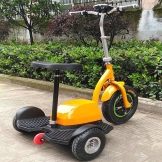
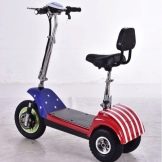
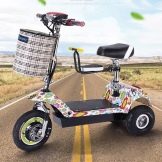
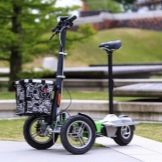
Manufacturers rating
The modern market for scooters offers a huge selection of three-wheeled models from different manufacturers. Below are the best samples, the positive reviews of which are very common on the Internet.
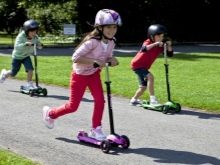
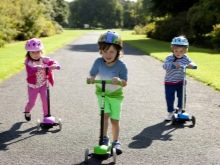
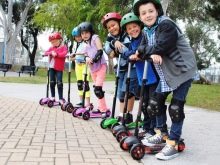
Children's 3-wheeled pink Hasbro scooter. My Little Pony is intended for children from 2 years. The model is able to withstand weight up to 60 kg, made of aluminum and equipped with polyurethane wheels with a diameter of 124 and 80 mm. The scooter is controlled by tilting the steering rack, the height of the steering wheel can vary from 60 to 80 cm, the deck size is 32x13.5 cm. The luminous wheels are equipped with strong ABEC 7 class bearings, do not slip on asphalt and do not make noise when driving. The model can be folded compactly, has a rear foot brake, is available in dimensions 58x27x60-80 cm, weighs 4 kg and costs 4,599 rubles.
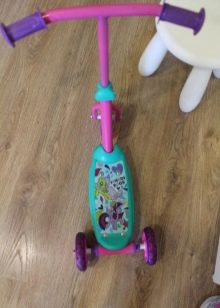
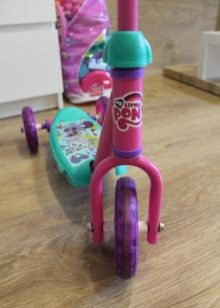
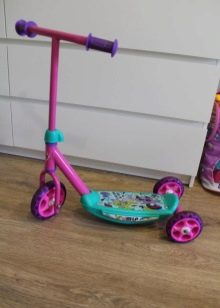
Children's three-wheeled scooter with a steering wheel Trolo MAXI 2017 Available in orange-blue and designed for children from 3 to 8 years. The model is designed for a weight load of up to 50 kg, has a telescopic steering wheel that can be adjusted to a height of 60 to 90 cm. The luminous wheels are made of polyurethane, have a diameter of 120 and 80 mm and are equipped with ABEC 5 class bearings. The deck has a size of 32x14 cm and is equipped with anti-slip coated.
The weight of the scooter is 2.5 kg, the cost is 2500 rubles.
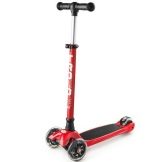

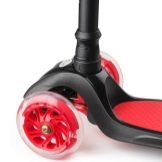
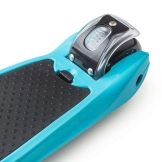
Teenage Scooter Trader Razor Powerwing Sweet Pea is an original and very thoughtful model. The rear wheels are mounted slightly at an angle, which allows you to enter it in a controlled skid, in other words - to drift. The product is equipped with a hand brake, designed for growth from 110 to 180 cm and can withstand up to 65 kg of weight. The scooter has a large and comfortable handlebar with a width of 35 cm, which can be extended to a height of 79.5 cm. The wheels are equipped with ABEC 5 class bearings, the frame is made of durable steel, and the deck-wings are made of high-quality polymers. The scooter is made in China, weighs 2.9 kg, has a 6-month warranty and costs 8,000 rubles.

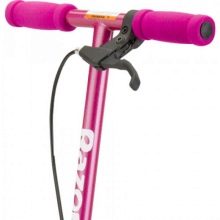
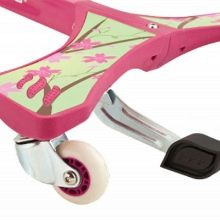
Adult butterfly scooter Razor Powerwing DLX designed not only for adolescents, but also for adults. The maximum weight load is 70 kg, while the weight of the scooter itself is 4.9 kg. The model is designed for users up to 190 cm tall, equipped with a 34.5 cm wide retractable steering wheel, and equipped with a folding mechanism. The height of the steering wheel varies from 73 to 89 cm, the warranty is 6 months, the cost is 10,900 rubles.

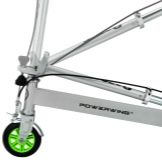
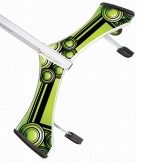
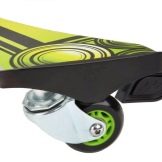
Tricycle electric scooter SF-8 Comfort Lite Designed for adults and adolescents over 12 years old. The model is equipped with a 250 W electric motor, a 24 V lead-acid rechargeable battery and a 12 A / h capacity. It takes 6 hours to fully charge the battery, and on one charge the scooter can travel up to 25 km. The product can withstand a rider weighing up to 80 kg, has a folding frame and is easily transported in the trunk of a passenger car. The mobile unit is so simple that even a child can assemble and disassemble a scooter.
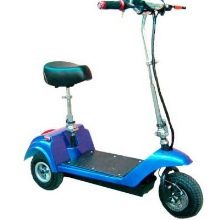
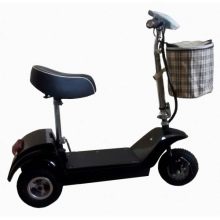
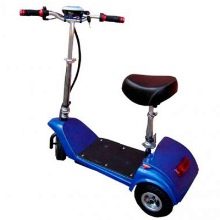
The model has wide pneumatic wheels with a size of 9 ”and a large comfortable steering wheel that rotates very easily. A battery remaining indicator is located on the telescopic handlebar and it is technically possible to install a luggage basket. The scooter is equipped with a spring-loaded rear suspension, manual disc brakes, side turn signals, front headlight, rear brake lights and horn.
The model is available in blue, black and red, weighs 22.5 kg and costs 27500 rubles.
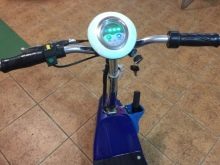

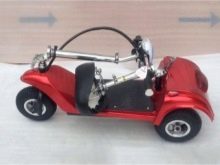
Selection tips
When choosing a three-wheeled scooter, you need to pay attention to a number of important points.
- Buying a model should be strictly according to the age of the child. It is not recommended to purchase transport "for growth", as the baby is not able to drive too large a scooter.
- You can buy a scooter on plastic wheels only if you plan to ride on a smooth asphalt road. In other cases, it is better to choose a model on rubber or polyurethane wheels.
- The rear brake wing on the children's scooter should be deep enough and grasp the wheel as tight as possible. From any position, the leg should accurately fall on the brake and not shift the wing to the side. If instead of a wide volumetric wing a straight narrow bar sticks out, then it is better to refuse to buy such a scooter, since it will not be able to provide safe braking.
- The scooter deck should be so wide that both feet fit on it. Too wide strips should not be chosen, as the child will be uncomfortable to push off the ground.
- Handles should be made of anti-slip material, and the steering wheel should be adjusted for the growth of the child.
- Of great importance is the weight of the scooter. It should not exceed 4 kg for children's models and 8 kg for teenagers and adults. An exception is electric scooters, which weigh between 22-25 kg.
- As for the size of the wheels, the diameter of 12-15 cm is considered optimal for older children, for children - 8-10 cm.
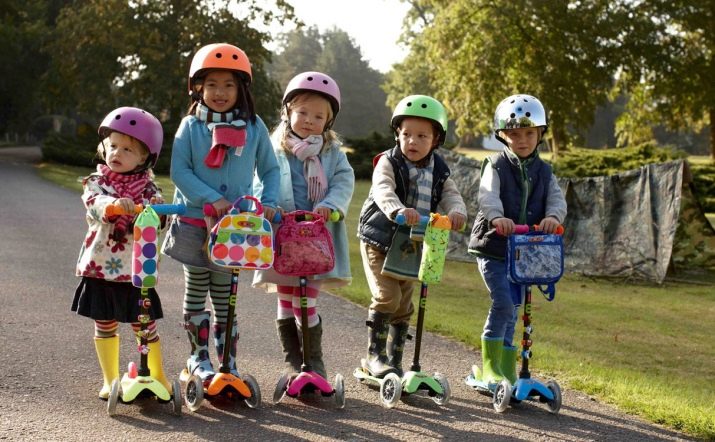

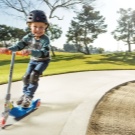
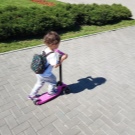
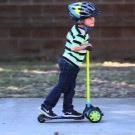

User's manual
When using a three-wheeled scooter, a number of simple rules must be observed.
- Before the first trip, you must make sure that the hand brake is working and test the operation of the rear brake wing.
- Then you need to adjust the steering wheel in height in accordance with the growth of the rider.
- If a small child rides a scooter, then he definitely needs to purchase knee pads, elbow pieces and a protective helmet.
- In rainy weather, using a scooter is undesirable. This is especially true for models with rubber wheels that do not behave too steadily on wet pavement.
- After each walk, the scooter must be wiped with a clean cloth and from time to time to check the presence of grease in the bearings.
Children and adolescents who ride scooters alone, without the presence of parents, should be familiar with the rules of the road.
